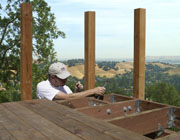A few months ago, the Today Show asked Simpson Strong-Tie to demonstrate a deck collapse to educate the public about deck safety. Often through the Fall and Winter months, decks go unused yet see a lot of activity from rain, sleet and snow. When the sun comes out in the Spring, people get out on their decks again without much thought about how the elements may have affected the important connections on their deck.
In addition to the weather, there are other factors to consider about deck safety:
- Experts agree that the average life expectancy of a wood deck is 10 to 15 years.
- It’s estimated that there are millions of decks in the U.S. that are beyond their useful life and may be unsafe.
- The number of deck collapses has increased in recent years.
- Within the past five years, 651 injuries and four deaths have occurred due to deck collapse.
So, I’m thinking about deck safety. I thought I’d share with you the “5 Warning Signs of an Unsafe Deck” we discussed on the Today Show:
1. Loose Connections. Wobbly railings or loose stairs are common on a deck, especially one that was built a few years ago. It’s important that you address these areas and make sure they’re properly secured. Decks age as they go through different seasons and the associated issues require annual inspection.
2. Missing Connections. Often loose connections mean missing connections. If a deck is off the ground – you want to go underneath it and make sure you have the proper hardware. Often a deck is held together with only nails. Toe-nailed connections can pull out – metal connectors are much stronger and can provide more load capacity. If connectors or fasteners are missing on a deck, you want to add them.
3. Corrosion. As mentioned earlier, a deck is exposed to weather and other outdoor conditions every day, which can cause the hardware on a deck to corrode or rust. If you see signs of red rust, you may need to replace the metal connectors or fasteners. Not all rust is bad – for instance white rust generally does not mean that the steel is corroding. To address corrosion issues when re-building or retrofitting a deck, you should use connectors that are coated for outdoor conditions. Using Simpson Strong-Tie® ZMAX or HDG or stainless steel connectors and fasteners can help protect the deck from corrosion.
4. Rotted Wood. Over time, wood can rot and weaken your deck. To test wood on a deck, stick a screw driver in the area of wood that you think is rotted. If it appears soft, it should be replaced immediately. Remember, the life expectancy of a wood deck is only about 10 to 15 years.
5. Cracked Wood If you see large cracks in any wood members, you should replace them.
For more information and resources on how to build and maintain a strong deck, including our “5 Steps to a Stronger, Safer Deck” brochure, visit our consumer site at www.safestronghome.com.
– Paul
What are your thoughts? Visit the blog and leave a comment!



